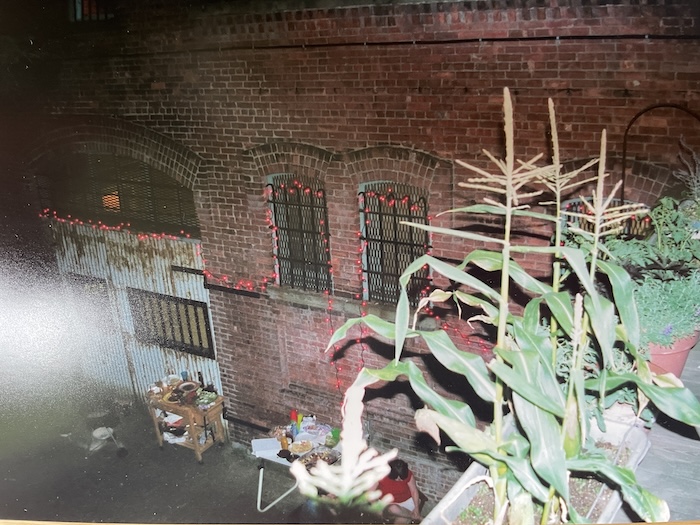My first experience growing plants in containers was in a rooftop garden in Brooklyn. The previous tenant left behind troughs and pots, and I was delighted to make use of them. I grew sweet corn, 8-foot sunflowers in clay pots and herbs of all flavors.
I learned from my farmer uncle that corn had to be planted in two rows, not a single line, because it’s wind-pollinated. I staggered a row of five in a curving line. That doesn’t yield a lot of corn, but I liked the way it looked, and it felt grounding to have these sturdy, waving stalks among the industrialness of the neighborhood.

The sunflowers were cheerful and untouched by the squirrels and chipmunks that keep me from growing them in Philipstown. At the end of the season, I would lop off the heads and give them to my neighbors, who kept chickens in an empty lot on the corner. The herbs were a sensory blast and sometimes used for cooking among the people who shared the space.
The setup dictated the growing conditions. The rooftop was accessible after many stairs and walking through the kitchen and a bedroom. Lugging heavy bags of soil or other materials was a drag. I improvised compost and filler with leaves I collected in the street for mulch.
There wasn’t any shade, and the black tar paper under the containers was blazing hot. Setting the pots on stands helped. Water came from a hose that ran up the fire ladder from the courtyard below and had to be turned on and off at ground level. Getting that parkour workout was a bonus.

Now I’m a flatlander, with acres of greenery and containers that form a border to keep people from falling off the patio. It was useful when my daughter was learning to walk. All were inherited from a previous owner or repurposed.
I appreciate having herbs like chives and basil nearby for cooking and dill to attract caterpillars that become butterflies. I grow lettuce because it’s close to the kitchen and easy to gather for salads. Sun-warmed cherry tomatoes, a summer luxury, are close at hand because everyone likes to grab one for a quick snack.
I have two window boxes to plant — a gift handmade and installed by my husband. I considered how nice they would look on the stone wall of our house but realized I don’t want to block the view from inside. I’m planning a low-growing mix with creeping thyme and stonecrop plants.
A few things to address when planting containers:
- For vegetables, look for plants labeled “patio,” which are bred to grow in small spaces.
- Watering is the most demanding part of container gardening. Larger pots allow for more soil volume that will dry out less quickly.
- Metal containers heat up fast and hold heat. Pottery is more stable temperature-wise but porous. Plastic is relatively stable, but it’s got all the relative issues of being plastic; it’s better to repurpose or acquire used plastic pots. Wood is a fine material.
- Commit to watering and set up a rain collection system nearby if possible. Monitor the soil daily if it isn’t raining.
- Think about layers and maximize space by using tall, medium and shorter plants to fill out the container.
- If you enjoy fresh mint, grow it in a container to avoid its inevitable colonization of a flowerbed. The same is true for other vigorous plants.
- Soil sold in bags labeled as “potting mixes” is blended to maximize nutrients and drainage. Avoid using garden soil or topsoil, which are denser.
- I’ve never used mulch in container gardening but in larger troughs or with bare soil it could help with water retention.
- It’s a myth that a layer of rocks at the bottom of a pot will help drainage. It makes it worse. Fill it with soil and make it snug around the plants to avoid air pockets.
- Mix perennials and annuals to lighten your workload. You don’t have to start from scratch every year.
- Many pollinator-attracting plants will happily grow in pots. A few of my favorites are butterflyweed (Asclepias tuberosa), foxglove beardtongue (Penstemon digitalis) and little bluestem, a native grass (Schizachyrium scoparium).


I started growing corn, peppers, carrots and blueberries in pots on my terrace in Manhattan when I was 10 years old. Everyone said I was nuts, and that nothing would ever grow. Then, one day, when my mom and I were walking home, I pointed to our terrace, on the 20th floor, and I said, “Look Mommy, my corn!” Sure enough, there was my corn peeking over the top; it eventually grew to 5 feet, with a beautiful ear. I grew corn and vegetables on that terrace every summer for another decade, until my husband and I bought our first home in Croton. Now we grow vegetables in our garden!